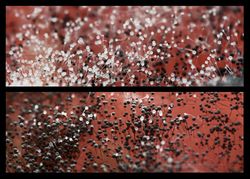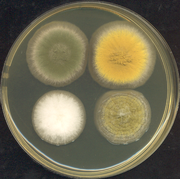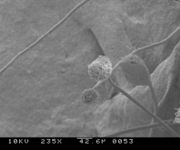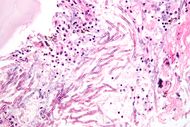Aspergillus
| Aspergillus | |
|---|---|
 |
|
| Conidial head of Aspergillus niger | |
| Scientific classification | |
| Domain: | Eukarya |
| Kingdom: | Fungi |
| Phylum: | Ascomycota |
| Class: | Eurotiomycetes |
| Order: | Eurotiales |
| Family: | Trichocomaceae |
| Genus: | Aspergillus |
| Species | |
|
Several hundred,[1] including: |
|
Aspergillus is a genus consisting of several hundred mold species found in various climates worldwide. Aspergillus was first catalogued in 1729 by the Italian priest and biologist Pier Antonio Micheli. Viewing the fungi under a microscope, Micheli was reminded of the shape of an aspergillum (holy water sprinkler), and named the genus accordingly.[2] Today "aspergillum" is also the name of an asexual spore-forming structure common to all Aspergilli; around one-third of species are also known to have a sexual stage.[1]
Contents |
Growth and distribution

Aspergillus species are highly aerobic and are found in almost all oxygen-rich environments, where they commonly grow as molds on the surface of a substrate, as a result of the high oxygen tension. Commonly, fungi grow on carbon-rich substrates such as monosaccharides (such as glucose) and polysaccharides (such as amylose). Aspergillus species are common contaminants of starchy foods (such as bread and potatoes), and grow in or on many plants and trees.
In addition to growth on carbon sources, many species of Aspergillus demonstrate oligotrophy where they are capable of growing in nutrient-depleted environments, or environments in which there is a complete lack of key nutrients. A. niger is a prime example of this; it can be found growing on damp walls, as a major component of mildew.
Commercial importance

Species of Aspergillus are important medically and commercially. Some species can cause infection in humans and other animals. Some infections found in animals have been studied for years. Some species found in animals have been described as new and specific to the investigated disease and others have been known as names already in use for organisms such as saprophytes. More than 60 Aspergillus species are medically relevant pathogens.[3] For humans there is a range of diseases such as infection to the external ear, skin lesions, and ulcers classed as mycetomas.
Other species are important in commercial microbial fermentations. For example, alcoholic beverages such as Japanese sake are often made from rice or other starchy ingredients (like manioc), rather than from grapes or malted barley. Typical microorganisms used to make alcohol, such as yeasts of the genus Saccharomyces, cannot ferment these starches, and so koji mold such as Aspergillus oryzae is used to break down the starches into simpler sugars.
Members of the genus are also sources of natural products that can be used in the development of medications to treat human disease.[4]
Perhaps the largest application of A. niger is as the major source of citric acid; this organism accounts for over 99% of global citric acid production, or more than 1.4 million tonnes per annum. A. niger is also commonly used for the production of native and foreign enzymes, including glucose oxidase and hen egg white lysozyme. In these instances, the culture is rarely grown on a solid substrate, although this is still common practice in Japan, but is more often grown as a submerged culture in a bioreactor. In this way, the most important parameters can be strictly controlled, and maximal productivity can be achieved. It also makes it far easier to separate the chemical or enzyme of importance from the medium, and is therefore far more cost-effective.
Research


A. nidulans has been used as a research organism for many years and was used by Guido Pontecorvo to demonstrate parasexuality in fungi. Recently, A. nidulans was one of the pioneering organisms to have its genome sequenced by researchers at the Broad Institute. As of 2008, a further seven Aspergillus species have had their genomes sequenced: the industrially useful A. niger (two strains), A. oryzae and A. terreus, and the pathogens A. clavatus, A. fischerianus (Neosartorya fischeri), A. flavus and A. fumigatus (two strains).[5] A. fischerianus is hardly ever pathogenic but is very closely related to the common pathogen A. fumigatus; it was sequenced in part to better understand A. fumigatus pathogenicity.[6]
Genomics
The simultaneous publication of three Aspergillus genome manuscripts in Nature in December 2005 established Aspergillus as the leading filamentous fungal genus for comparative genomic studies. Like most major genome projects, these Aspergillus efforts were collaborations between a large sequencing centre and the respective community of scientists. For example, the Institute for Genome Research (TIGR) worked with the Aspergillus fumigatus community. A. nidulans was sequenced at the Broad Institute. A. oryzae was sequenced in Japan at the National Institute of Advanced Industrial Science and Technology. The Joint Genome Institute ( JGI) of the Department of Energy has released sequence date for a citric acid-producing strain of A. niger. TIGR, now re-named the Venter Institute is currently spear-heading a project on the A. flavus genome.[7]
Genome sizes for sequenced species of Aspergillus range from approximately 29.3 Mb for A. fumigatus to 37.1 Mb for A. oryzae while the numbers of predicted genes vary from approximately 9926 for A. fumigatus to approximately 12,071 for A. oryzae. The genome size of an enzyme producing strain of A. niger is of intermediate size at 33.9 Mb.[2]
Pathogens
Some Aspergillus species cause serious disease in humans and animals. The most common causing pathogenic species are Aspergillus fumigatus and Aspergillus flavus. Aspergillus flavus produces aflatoxin which is both a toxin and a carcinogen, and which can potentially contaminate foods such as nuts. The most common causing allergic disease are Aspergillus fumigatus and Aspergillus clavatus. Other species are important as agricultural pathogens. Aspergillus spp. cause disease on many grain crops, especially maize, and synthesize mycotoxins including aflatoxin.
Aspergillosis

Aspergillosis is the group of diseases caused by Aspergillus. The most common subtype among paranasal sinus infections associated with aspergillosis is Aspergillus fumigatus.[8] The symptoms include fever, cough, chest pain or breathlessness, which also occur in many other illnesses so diagnosis can be difficult. Usually, only patients with already weakened immune systems or who suffer other lung conditions are susceptible.
In humans, the major forms of disease are:
- Allergic bronchopulmonary aspergillosis or ABPA, which affects patients with respiratory diseases like asthma, cystic fibrosis, and sinusitis).
- Acute invasive aspergillosis, a form that grows into surrounding tissue, more common in those with weakened immune systems such as AIDS or chemotherapy patients.
- Disseminated invasive aspergillosis, an infection spread widely through the body.
- Aspergilloma, a "fungus ball" that can form within cavities such as the lung
Aspergillosis of the air passages is also frequently reported in birds, and certain species of Aspergillus have been known to infect insects.[3]
See also
- Mycotoxin
- Sick building syndrome (SBS)
- Mold health issues
References
- ↑ 1.0 1.1 PMID 18608901 (PubMed)
Citation will be completed automatically in a few minutes. Jump the queue or expand by hand - ↑ 2.0 2.1 Bennett JW (2010). "An Overview of the Genus Aspergillus". Aspergillus: Molecular Biology and Genomics. Caister Academic Press. ISBN 978-1-904455-53-0.
- ↑ 3.0 3.1 Thom C, Church M. The Aspergilli. Baltimore: The Williams & Wilkins Company, 1926.
- ↑ US 6069146
- ↑ PMID 19146970 (PubMed)
Citation will be completed automatically in a few minutes. Jump the queue or expand by hand - ↑ "Descriptions - Aspergillus Comparative". Broad Institute. http://www.broadinstitute.org/annotation/genome/aspergillus_group/GenomeDescriptions.html. Retrieved 2009-10-15.
- ↑ Machida, M; Gomi, K (editors) (2010). Aspergillus: Molecular Biology and Genomics. Caister Academic Press. ISBN 978-1-904455-53-0.
- ↑ Bozkurt MK, Ozcelik T, Saydam L, Kutluay L. [A case of isolated aspergillosis of the maxillary sinus]. Kulak Burun Bogaz Ihtis Derg. 2008; 18(1): 53-5.
- Du C, Lin SK, Koutinas A, Wang R, Dorado P, Webb C. “A wheat biorefining strategy based on solid-state fermentation for fermentative production of succinic acid.” Bioresour Technol. 21 April 2008.
- Zirbes JM, Milla CE. “Steroid-Sparing effect of omalizumab for allergic bronchopulmonary aspergillosis and cystic fibrosis”. 23 April 2008; 43(6):607-610.
External links
- Aspergillus Genome Resources (NIH)
- Aspergillus Comparative Database Comparative genomic resource at the Broad Institute
- Central Aspergillus Data Repository
- The Fungal Genetics Stock Center
- The Aspergillus/Aspergillosis Website An encyclopedia of Aspergillus for patients, doctors and scientists
- Aspergillus surveillance project at a large tertiary-care hospital. (PDF).
- The Aspergillus Genome Database